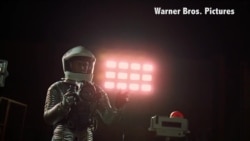It was 50 years ago that the science fiction film 2001: A Space Odyssey opened in theaters across the United States.
The film, directed by Stanley Kubrick, was based on a book by Arthur C. Clarke.
The almost three-hour long movie opened to mixed reviews in 1968. Critics said it was too cerebral and slow to be understood by movie goers.
Today the movie is one of the American Film Institute’s top 100 films of all time.
Douglas Trumbull is a movie director. Fifty years ago, he was a special photographic effects supervisor in the 2001 production. He describes Stanley Kubrick as a perfectionist who spent four years making the film.
Trumbull said that Kubrick started out by planning to make the film like other movies, with tensions and excitement building throughout the storyline. But then he began removing all of the usual theatrical elements because he was working on a large 70 millimeter widescreen film.
The movie became “more immersive” and the more experimental it became, the less you had to talk about, Trumbull noted.
To create this experience Kubrick built what Trumbull calls “a centrifuge set -- the big center piece of the movie.”
The cameras were tied on the rotating set and were filming in 360 degrees. This is how Kubrick created the images of the astronauts walking from the floor to the top of the spaceship.
And then there was the music...
2001: A Space Odyssey is remembered for its use of classical music, instead of music specially created for the film.
The music of Johann Strauss' “Blue Danube Waltz” is in step with Kubrick’s slow moving images of space. And the Richard Strauss work “Also Sprach Zarathustra” became a classical hit because of the movie.
In 1968, movie goers watched the film on huge screens with rounded edges in theaters. They walked away with Kubrick’s message: life on Earth was aided by intelligent life from outer space.
Kubrick did not use well known images of otherworldly beings. Instead, the alien presence appears suddenly, sending signals that teach ape-like creatures how to use tools for hunting and survival. Millions of years later, in Kubrick’s imagined high tech world of 2001, the aliens make contact again. They urge human beings to explore the planet Jupiter.
“And they get to Jupiter and that’s where the transformation takes place,” said Trumbull.
The only astronaut still alive on the spacecraft, Dave Bowman, leaves his body after making contact with the aliens. He enters a stargate, which takes him to another part of the universe.
Trumbull takes credit for the special effects that created the film’s famous Stargate. He also found realistic ways to show the Earth and distant stars.
Trumbull compares Kubrick’s filming of 2001 to current-day Virtual Reality filmmaking.
“You know,” he said, “the time when the 2001 was made, it was in a time of…a Sound of Music, West Side Story, and giant screen theaters and you would go out, it was a big deal to go out to see a big screen movie.”
Equally important to the technology is the film’s plot. “The idea was that some super intelligent…civilization way beyond our imagination that to us would look like a God…was intervening in human affairs from time to time just to make sure we got through,” Trumbull said.
The movie explored the relationship between man and machine. Bowman and Hal, the ship’s computer, fight for control of the ship.
Bowman wins. The film ends with Bowman in a hotel room the aliens have created from his memory so they can contact him. He is a dying old man. He is finally transformed into a star.
To celebrate the film’s 50th anniversary, artist Simon Birch recreated that hotel room. His model can be seen at the Smithsonian Institution’s Air and Space Museum in Washington, DC.
2001: A Space Odyssey has been re-released in IMAX theaters across the country to celebrate its 50th anniversary. The movie feels as important now as ever.
I’m Susan Shand
VOA’s Penelope Poulou reported this story and Susan Shand adapted it for Learning English. George Grow was the editor.
_____________________________________________________________
Words in This Story
review – n. a report that gives someone's opinion about the quality of a book, performance
cerebral – adj. related to the mind rather than to feelings
institute – n. an organization created for a particular purpose
photographic – adj. relating to or used to make photographs
immersive – adj. complete involvement in some activity or interest
centrifuge – n. a machine that uses centrifugal force to separate substances or parts of substances
rotate – v. to move or turn in a circle
degrees – n. a unit for measuring the size of an angle
transformation – n. a complete or major change in someone's or something's appearance, form, etc.
plot – n. a series of events that form the story in a novel, movie









